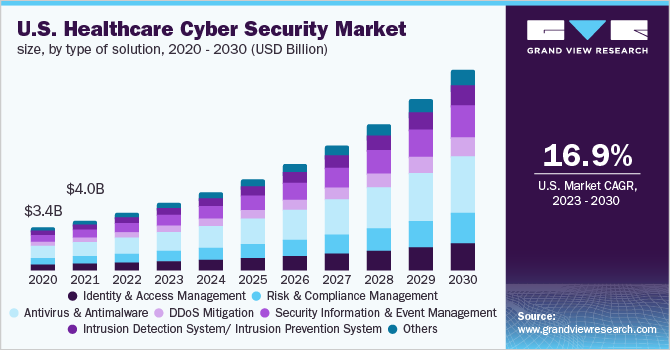Healthcare Cyber Security Market Share and Business Opportunity to 2030
Healthcare Cyber Security Market Growth & Trends
The global healthcare cyber security market size is expected to reach USD 56.3 billion by 2030, according to a new report by Grand View Research, Inc. The market is expected to expand at a CAGR of 18.4% from 2023 to 2030. An increasing number of cyber-attacks in the healthcare industry, a raise in threats, and concern for privacy and security are contributing to the growth of the market. The increase in cases of cyber-attacks and data breaches globally has raised the concern thereby, increasing demand for cyber security. For instance, the Secretary of U.S. Department of Health and Human Services (HHS) Breach of Unsecured Protected Health Information listed 592 breaches of unsecured protected health data affecting more than 500 individuals within the last two years that are currently under investigation by the Office for Civil Rights. 306 of the breaches were submitted in 2020.

Healthcare Cyber Security Market Segmentation
Grand View Research, Inc. has segmented the global healthcare cyber security market on the basis of type of solutions, type of threats, end use, type of security, deployment, and region:
Based on the Types of Solution Insights, the market is segmented into Identity and Access Management, Risk and Compliance Management, Antivirus and Antimalware, DDoS Mitigation, Security Information and Event Management, Intrusion Detection System/ Intrusion Prevention System, Others.
- Antivirus and Antimalware segment dominated the market with 25.6% share in 2022. Various solutions have been developed to tackle the different threats. Some of the key solutions include identity and access management, risk and compliance management, Security Information and Event Management (SIEM), Intrusion Detection System (IDS)/Intrusion Prevention System (IPS), and data encryption software, firewalls, antivirus, antimalware software, and others. Antivirus and Antimalware segment is anticipated to grow at a fastest CAGR of 19.3% due to the increase in the usage of such solutions. It is attributed to a surge in the number of malware attacks in the healthcare industry, which is shutting down the networks and affecting patient care.
Based on the Type of Threat Insights, the market is segmented into Malware, DDoS, Advanced Persistent Threat, Spyware, Lost or Stolen Devices, Others.
- Malware segment dominated the market with 25.4% share in 2022. The healthcare industry has multiple cyber security-related issues. It includes malware that compromises system integrity and patient privacy, Distributed Denial of Service (DDoS) attacks that disrupt providers' ability to provide effective patient care. The ransomware attack is the extensively used malware type due to the awareness and preferences of the hackers for ransomware.
- A minimum of 92 healthcare organizations in the U.S. suffered ransomware attacks in 2020, which resulted in an average ransom demand of USD 169,446 and netting criminals approximately USD 15.6 million in ransoms demanded from the healthcare industry in the U.S. Also, according to Emsisoft, 560 healthcare facilities fell victim to ransomware attacks by the malware variant in 2020. Moreover, the advanced persistence threat segment is witnessing lucrative growth and is anticipated to witness a higher CAGR over the forecast period.
Based on the End-use Insights, the market is segmented into Pharma & Chemicals, Medical Devices, Health Insurance, Hospitals, Others.
- As of 2022, the hospital segment held the largest revenue share of around 62.9%. Hospitals are extremely vulnerable to cyber-attack as it stores an incredible amount of patient data. In addition, these attacks are spiked during the pandemic threatening private data and patient care. It will be increasing the use of cyber security. For instance, a security breach at Blackbaud, a cloud computing company, resulted in the exposure of patient data from more than 46 health systems and hospitals.
- According to a report published in 2018 in the American Journal of Managed Care, annual spending on advertising increased by 64.0% for the next two years after a security breach in hospitals. This additional expense allows hospitals to rebuild their age and retain their patients against their competitors in the market. Such costs to the healthcare system can be avoided by implementing a better data security system, which is estimated to drive cyber security spending in hospitals.
Healthcare Cyber Security Regional Outlook
- North America
- Europe
- Asia Pacific
- Latin America
- Middle East & Africa
Market Share Insights
- November 2021: IBM announced it would extend its cyber security and response capabilities by acquiring ReaQta, a Dutch cyber security threat detection and response company.
Key Companies Profile & Market Share Insights
Key market players are continuously investing in the development of products with advanced technologies to gain a competitive edge over others in the market, which is expected to drive the growth of the market for healthcare cyber security.
Some of the prominent players operating in the global healthcare cyber security market include,
- Cisco
- IBM
- FireEye
- Symantec
- Trend Micro
- MacAfee
- Intel
- Kaspersky
- Lockheed Martin
- Northrop Grumman
- Imperva Inc
- Fortinet Inc
- Medigate Ltd
Order a free sample PDF of the Healthcare Cyber Security Market Intelligence Study, published by Grand View Research.
Comments
Post a Comment